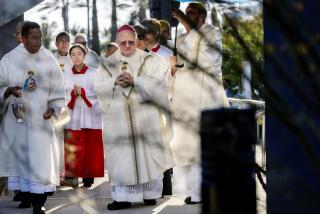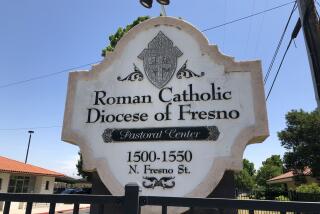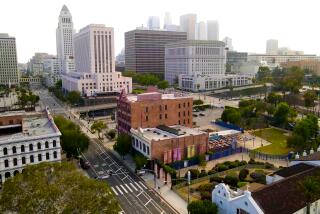Cardinal Mahony used cemetery money to pay sex abuse settlement

Pressed to come up with hundreds of millions of dollars to settle clergy sex abuse lawsuits, Cardinal Roger M. Mahony turned to one group of Catholics whose faith could not be shaken: the dead.
Under his leadership in 2007, the Archdiocese of Los Angeles quietly appropriated $115 million from a cemetery maintenance fund and used it to help pay a landmark settlement with molestation victims.
The church did not inform relatives of the deceased that it had taken the money, which amounted to 88% of the fund. Families of those buried in church-owned cemeteries and interred in its mausoleums have contributed to a dedicated account for the perpetual care of graves, crypts and grounds since the 1890s.
Mahony and other church officials also did not mention the cemetery fund in numerous public statements about how the archdiocese planned to cover the $660-million abuse settlement. In detailed presentations to parish groups, the cardinal and his aides said they had cashed in substantial investments to pay the settlement, but they did not disclose that the main asset liquidated was cemetery money.
In response to questions from The Times, the archdiocese acknowledged using the maintenance account to help settle abuse claims. It said in a statement that the appropriation had “no effect” on cemetery upkeep and enabled the archdiocese “to protect the assets of our parishes, schools and essential ministries.”
Under cemetery contracts, 15% of burial bills are paid into an account the archdiocese is required to maintain for what church financial records describe as “the general care and maintenance of cemetery properties in perpetuity.”
Day-to-day upkeep at the archdiocese’s 11 cemeteries and its cathedral mausoleum is financed by cemetery sales revenue separate from the 15% deposited into the fund, spokeswoman Carolina Guevara said. Based on actuarial predictions, it would be at least 187 years before cemeteries are fully occupied and the church started to draw on the maintenance account, she said.
“We estimate that Perpetual Care funds will not be needed until after the year 2200,” Guevara wrote in an email.
The church’s use of fund money appears to be legal. State law prohibits private cemeteries from touching the principal of their perpetual care funds and bars them from using the interest on those funds for anything other than maintenance. Those laws, however, do not apply to cemeteries run by religious organizations.
Mary Dispenza, who received a 2006 settlement from the archdiocese over claims of molestation by her parish priest in the 1940s, said her great-uncle and great-aunt are buried in Calvary Cemetery in East L.A.
“I think it’s very deceptive,” she said of the way the appropriation was handled. “And I think in a way they took it from people who had no voice: the dead. They can’t react, they can’t respond.”
The fund dates to the tenure of Bishop Francis Mora, who opened Calvary in 1896. An official archdiocese history published in 2006 recounts how the faithful of Mora’s era were assured their money was “in the custody of an organization of unquestionable integrity and endurance” — the Catholic Church.
Over the next century, the archdiocese built more cemeteries, and each person laid to rest meant a new deposit into the maintenance account. By the time of the sex abuse settlement, there were cemeteries from Pomona to Santa Barbara and $130 million in the fund. Church officials removed $114.9 million in October 2007.
“Management plans to repay these appropriated funds from future cemetery sales ... after all liabilities associated with the lawsuits ... are paid off,” a December 2012 church financial report stated.
It’s unclear when that will happen. The archdiocese is still repaying a $175-million loan it took to help cover the settlement. Archbishop Jose Gomez, who took over from Mahony two years ago, is mulling over a $200-million fundraising campaign. Cemeteries have been a reliable source of income for the church, and the use of the upkeep-fund money is one of several ways the archdiocese is depending on them to erase its abuse debts.
When Mahony agreed to the settlement six years ago, he did so knowing his archdiocese couldn’t afford it. But he had little choice. If cases brought by more than 500 victims went to trial, the archdiocese feared it could be facing jury awards and legal bills in excess of $1 billion.
The deal reached after lengthy negotiations paid an average of $1.3 million per victim. Even with contributions from its insurance companies, religious orders and others, the archdiocese was on the hook for more than $300 million, vastly more cash than it had on hand.
Bishops in other cities had closed parishes and schools or filed for bankruptcy, moves that angered the faithful and that Mahony wanted to avoid. He went to Rome at least twice to consult with Vatican officials, who must approve the transfer of archdiocese property worth more than $10 million. He later told the National Catholic Reporter he got permission to “alienate” — the Vatican’s term for sale or transfer — $200 million in church assets. Asked whether the Vatican had signed off on the use of cemetery funds, archdiocese Chief Financial Officer Randolph E. Steiner said in a statement, “All approvals under the Church’s Code of Canon Law were obtained.”
After the settlement, Mahony and others from the archdiocese said publicly that the money would come from administrative cuts, liquidation of investments, a bank loan and sales of real estate not directly related to their religious mission. Such real estate included the archdiocese’s Wilshire Boulevard headquarters, which eventually sold for $31 million.
Three months later, with no announcement, the archdiocese reached into the cemetery account. Steiner said that during an internal review of church assets, the money “was determined to be excess funding and was made available to the 2007 settlement.”
The maintenance money and a loan from an Irish bank were enough to begin paying victims but not enough to cover the entire bill. So Mahony and his aides sought contributions directly from parishes in 2008, and when they did, they said nothing about the cemetery fund.
In 19 presentations to parish groups about the archdiocese’s need for contributions that winter, the cardinal and his aides laid out what they had done so far to pay the settlement, including selling real estate and liquidating $117 million in investments. But they did not reveal that the cemetery fund accounted for nearly all the investments liquidated.
In a statement, the archdiocese said that the appropriation was disclosed in an annual financial report and that people attending the presentations “were informed that the financial statement was publicly available” on its website. But the report available at the time of the 2008 presentations did not mention the cemetery fund in a section dedicated to the archdiocese plans to pay the abuse settlement. When the removal of the funds was noted — in a paragraph about cemetery care — the report said $75 million was taken, an understatement of $39.9 million. The church corrected the number in subsequent reports.
Church spokeswoman Guevara noted that there were additional presentations in 2009 and 2010, by which point the financial reports accurately reflected the size of the appropriation.
In the same period the archdiocese appropriated the maintenance money, church officials tapped a for-profit Louisiana company, Stewart Enterprises, to take over “pre-need” cemetery sales, in which people pay in advance for their own funeral arrangements. Stewart’s commissioned salespeople use tablet computers and mobile printers to draw up contracts on church steps and customers’ homes, according to the company’s 2011 annual report, and the archdiocese wrote in its financial reports that Stewart would “accelerate” such sales to generate cash to pay back the settlement loans.
The church’s fiscal 2012 financial report noted $22 million in new cemetery contracts that year. It said parish “awareness sessions” about the benefits of Catholic burial were ongoing and a new marketing campaign was planned for 2013.
“Management believes the marketing initiative will measurably increase sales,” the report said.
Fred Rinaldi, who received a settlement from the archdiocese over allegations of molestation by his parish priest in the 1950s and 1960s, buried both of his parents in Holy Cross Cemetery in Culver City. Told of the appropriation of cemetery funds for the abuse payout, Rinaldi initially called it “just disgusting.”
But after reflecting on his parents’ devotion to the Catholic faith, he said they probably would have approved.
“Knowing my parents, I feel that’s how they would have reacted,” he said. Rinaldi said that both he and his mother eventually forgave defrocked priest Carl Sutphin and that Sutphin attended his mother’s funeral Mass last year.
“She was a true, true Christian.... She forgave and moved on,” he said.
More to Read
Sign up for Essential California
The most important California stories and recommendations in your inbox every morning.
You may occasionally receive promotional content from the Los Angeles Times.











